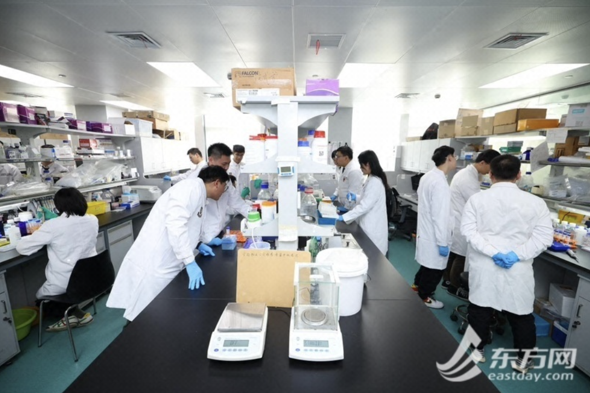- News
Empowering rare disease drug research: Shanghai General Hospital announces a precision cohort for pediatric osteosarcoma, a rare disease
赋能罕见病医药研发 上海市一医院发布儿童骨肉瘤罕见病精准队列
According to reports by Hu Yang, a correspondent from Eastday, and journalist Liu Yilin on July 17, osteosarcoma is one of the most common solid tumors among children and adolescents, ranking as the third leading cause of cancer-related deaths in individuals under 20 years old. However, due to various limitations, such as funding constraints, the development of new drugs and clinical research for bone tumors has been significantly challenging. This has led to the 'Double 40' bottleneck, referring to the lack of breakthrough advancements in new drug research over the past 40 years and a 5-year survival rate for malignant bone tumors of less than 40%.

In recent days, the "Pediatric Osteosarcoma Rare Disease Precision Cohort," established jointly by the Department of Bone Oncology at Shanghai General Hospital and the Shanghai Institute of Bone Oncology, was officially launched. This cohort spans over a decade and includes clinical data from more than 300 cases of osteosarcoma, along with comprehensive multi-genomic data exceeding 30 terabytes. It is one of the largest osteosarcoma datasets available both domestically and internationally. Currently, this cohort has been made accessible through the national sharing platform, supporting clinical research and drug development efforts at multiple research institutes and leading biopharmaceutical companies.
Over the years, there has been no significant improvement in the five-year survival rate of malignant bone tumors. Clinical challenges such as metastasis, drug resistance, and precise resection and reconstruction remain pressing issues," said Cai Zhengdong, the academic leader of the Orthopedic Center at Shanghai General Hospital and Director of the Shanghai Bone Tumor Research Institute, “against this backdrop, our need for new technologies and drugs has become even more urgent."
Notably, on June 21st, the Shanghai Municipal Health Commission and nine other departments jointly issued the "Implementation Plan for Further Strengthening the Construction and Research of Medical Cohorts in Shanghai," which explicitly calls for "strengthening the construction and research of medical cohorts to support medical innovation in Shanghai, healthcare decision-making, and the development of the health industry." The recent release of a precision clinical cohort by the Bone Tumor Department of Shanghai General Hospital and the Shanghai Bone Tumor Research Institute, and its subsequent availability on the national sharing platform, aims to leverage multi-institutional and interdisciplinary collaboration. This initiative seeks to strengthen the connection between clinical specialties and the pharmaceutical industry, accelerating the conduct of clinical trials and the translation of research findings into practical applications.
According to Hua Yingqi, Deputy Director of the Shanghai Bone Tumor Research Institute, with the support of the Shanghai Shenkang Hospital Development Center, the institute has previously established specialized databases for bone tumors, a large-scale biobank for Chinese populations, as well as genomic databases, and PDX and organoid model libraries. These standardized databases are at the forefront of the bone tumor field in China, providing a solid foundation for clinical research. Based on this cohort, the Bone Tumor Department at Shanghai General Hospital published the world's first clinical molecular classification method for osteosarcoma in 2022. This method can effectively identify highly malignant and metastatic subtypes with poor prognosis, gaining recognition and validation from international peers. Another clinical trial of a domestic new drug targeting highly malignant subtypes is also underway.

The clinical and research teams from the Department of Bone Tumors at the Shanghai General Hospital and the Shanghai Bone Tumor Institute are jointly leading research in various areas such as cell therapy, targeted drugs, and medical devices. Some of these studies have already entered Phase I and Phase II clinical trials. In April of this year, both parties initiated the establishment of the Shanghai Bone Tumor Innovative Drug and Device Development Alliance, aiming to promote the research, development, and application of new drugs and devices for bone tumors. Looking ahead, the two entities will continue to deepen their efforts in constructing a precise osteosarcoma cohort, establishing a mechanism for acquiring and sharing multicenter data nationwide. This initiative aims to empower the rare disease biopharmaceutical industry and contribute the "Shanghai General Hospital Cohort" to the "Shanghai Solution" for osteosarcoma.
Chen Zhiqiang, Vice President and Secretary-General of the Shanghai Rare Disease Prevention and Treatment Foundation; Qian Biyun, Director of the Clinical Research Promotion and Development Department at the Shanghai Shenkang Hospital Development Center; Lian Yuqiang, Professor and Doctoral Supervisor at East China University of Political Science and Law, and Vice Chairman of the Administrative Review Professional Committee of the China Administrative Law Society; and Li Zhizhong, Secretary-General of the Shenzhen Shiyu Children's Charity Foundation, attended the press conference. They collectively explored new pathways for rare disease drug development and precision treatment of pediatric osteosarcoma.
